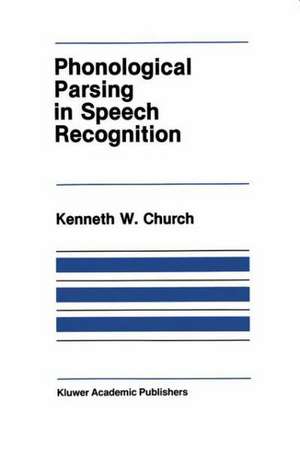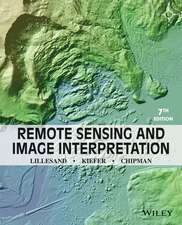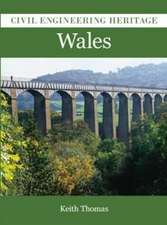Phonological Parsing in Speech Recognition: The Springer International Series in Engineering and Computer Science, cartea 38
Autor K. Churchen Limba Engleză Paperback – 12 oct 2011
Din seria The Springer International Series in Engineering and Computer Science
- 24%
 Preț: 1041.97 lei
Preț: 1041.97 lei - 20%
 Preț: 643.50 lei
Preț: 643.50 lei - 18%
 Preț: 1225.62 lei
Preț: 1225.62 lei - 18%
 Preț: 965.02 lei
Preț: 965.02 lei - 20%
 Preț: 646.12 lei
Preț: 646.12 lei - 18%
 Preț: 948.79 lei
Preț: 948.79 lei - 20%
 Preț: 646.62 lei
Preț: 646.62 lei - 15%
 Preț: 637.46 lei
Preț: 637.46 lei - 20%
 Preț: 643.83 lei
Preț: 643.83 lei - 18%
 Preț: 949.23 lei
Preț: 949.23 lei - 20%
 Preț: 644.48 lei
Preț: 644.48 lei - 20%
 Preț: 994.92 lei
Preț: 994.92 lei - 20%
 Preț: 645.97 lei
Preț: 645.97 lei - 18%
 Preț: 946.87 lei
Preț: 946.87 lei - 20%
 Preț: 995.57 lei
Preț: 995.57 lei - 18%
 Preț: 956.99 lei
Preț: 956.99 lei - 20%
 Preț: 644.98 lei
Preț: 644.98 lei - 15%
 Preț: 649.54 lei
Preț: 649.54 lei - 18%
 Preț: 950.21 lei
Preț: 950.21 lei - 18%
 Preț: 1221.38 lei
Preț: 1221.38 lei - 18%
 Preț: 957.62 lei
Preț: 957.62 lei - 15%
 Preț: 643.99 lei
Preț: 643.99 lei - 18%
 Preț: 948.47 lei
Preț: 948.47 lei - 18%
 Preț: 947.35 lei
Preț: 947.35 lei - 20%
 Preț: 1284.65 lei
Preț: 1284.65 lei - 20%
 Preț: 1633.95 lei
Preț: 1633.95 lei - 20%
 Preț: 1285.78 lei
Preț: 1285.78 lei
Preț: 643.34 lei
Preț vechi: 756.86 lei
-15% Nou
Puncte Express: 965
Preț estimativ în valută:
123.12€ • 127.19$ • 102.47£
123.12€ • 127.19$ • 102.47£
Carte tipărită la comandă
Livrare economică 26 martie-09 aprilie
Preluare comenzi: 021 569.72.76
Specificații
ISBN-13: 9781461292005
ISBN-10: 146129200X
Pagini: 284
Ilustrații: 272 p.
Dimensiuni: 178 x 254 x 15 mm
Greutate: 0.5 kg
Ediția:Softcover reprint of the original 1st ed. 1987
Editura: Springer Us
Colecția Springer
Seria The Springer International Series in Engineering and Computer Science
Locul publicării:New York, NY, United States
ISBN-10: 146129200X
Pagini: 284
Ilustrații: 272 p.
Dimensiuni: 178 x 254 x 15 mm
Greutate: 0.5 kg
Ediția:Softcover reprint of the original 1st ed. 1987
Editura: Springer Us
Colecția Springer
Seria The Springer International Series in Engineering and Computer Science
Locul publicării:New York, NY, United States
Public țintă
ResearchCuprins
1. Introduction.- 1.1 Historical Background and Problem Statement.- 1.2 Allophonic Constraints are Useful.- 1.3 Problems with Rewrite-Rules.- 1.4 Trends Toward Larger Constituents.- 1.5 Parsing and Matching.- 1.6 Summary.- 1.7 Outline of What’s To Come.- 2. Representation of Segments.- 2.1 Stevens’ Theory of Invariant Features.- 2.2 Our Position.- 2.3 What’s New.- 2.4 Motivations for Representing Phonetic Distinctions.- 2.5 Capturing Generalizations.- 2.6 Summary.- 3. Allophonic Rules.- 3.1 Flapping and Syllable Level Generalizations.- 3.2 Non-Linear Formulations of Flapping.- 3.3 Implementation Difficulties and the Lexical Expansion Solution.- 4. An Alternative: Phrase-Structure Rules.- 4.1 PS Trees Bear More Fruit Than You Would Have Thought.- 4.2 The Constituency Hypothesis.- 4.3 Advantages of Phrase-Structure Formulation.- 4.4 Summary.- 5. Parser Implementation.- 5.1 An Introduction to Chart Parsing.- 5.2 Representation Issues.- 5.3 A Parser Based on Matrix Operations.- 5.4 No Recursion.- 5.5 Order of Evaluation.- 5.6 Feature Manipulation.- 5.7 Additional Lattice Operations.- 5.8 Debugging Capabilities.- 5.9 Summary.- 6. Phonotactic Constraints.- 6.1 The Affix Position.- 6.2 The Length Restriction.- 6.3 The Sonority Hierarchy.- 6.4 Practical Applications of Phonotactic Constraints.- 6.5 Summary.- 7. When Phonotactic Constraints are Not Enough.- 7.1 Basic Principles.- 7.2 Against Stress Resyllabification.- 7.3 Practical Applications of Vowel Resyllabification.- 7.4 Automatic Syllabification of Lexicons.- 7.5 Summary.- 8. Robustness Issues.- 8.1 Alternatives in the Input Lattice.- 8.2 Problems for Parsing.- 8.3 Relaxing Phonological Distinctions.- 8.4 Conservation of Distinctive Features.- 8.5 Probabilistic Methods.- 8.6 Distinctive Features.- 8.7 Summary.- 9.Conclusion.- 9.1 Review of the Standard Position.- 9.2 Review of Nakatani’s Position.- 9.3 Review of the Constituency Hypothesis.- 9.4 Review of Phonotactic Constraints.- 9.5 Comparison with Syntactic Notions of Constituency.- 9.6 Contributions.- References.- Appendix I. The Organization of the Lexicon.- I.1. Linear Representation and Linear Search.- I.2. Non-Recursive Discrimination Networks.- I.3. Recursive Discrimination Networks.- I.4. Hash Tables Based on Equivalence Class Abstractions.- I.5. Shipman and Zue.- I.6. Morse Code.- I.7. Selecting the Appropriate Gross Classification.- I.8. Summary.- Appendix II. Don’t Depend Upon Syntax and Semantics.- II.1. Higher Level vs. Lower Level Constraints.- II.2. Too Much Dependence in the Past.- II.3. How Much Can Higher Constraints Help?.- II.4. Detraction from the Important Low-Level Issues.- II.5. New Directions: Recognition without Understanding.- II.6. Lower-Level Constraints Bear More Fruit.- II.7. Summary.- Appendix III. Lexical Phonology.- III.1. Difference Between + and #.- III.2. Pipeline Design.- III.3. Distinctions Between Lexical and Postlexical Rules.- III.4. Which Rules are Lexical and Which are Postlexical?.- III.5. The Implementation of Lexical and Postlexical Rules.- Appendix IV. A Sample Grammar.- Appendix V. Sample Lexicon.- Appendix VI. Sample Output.











